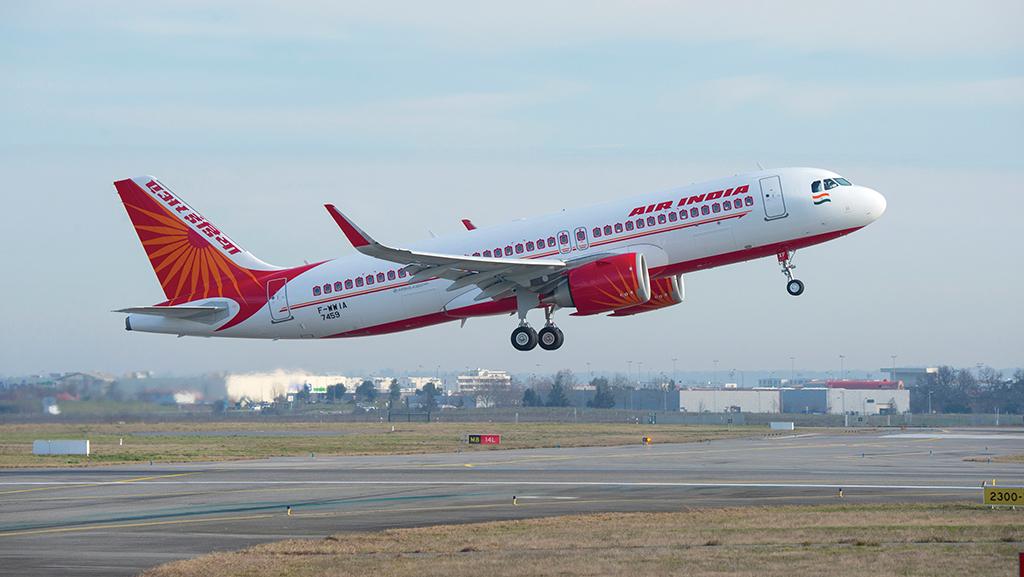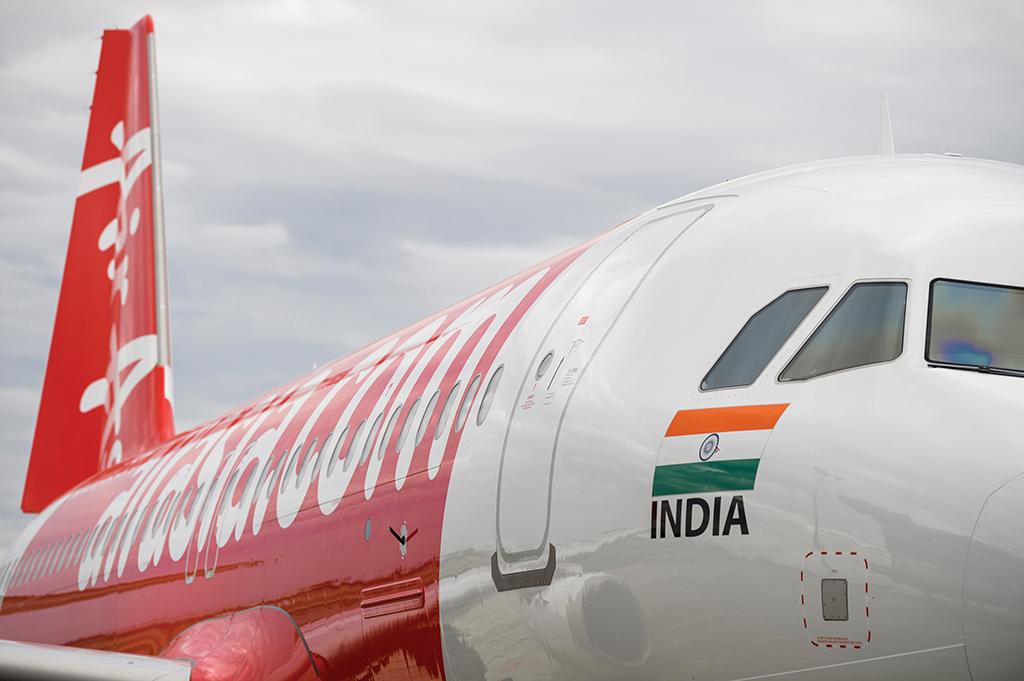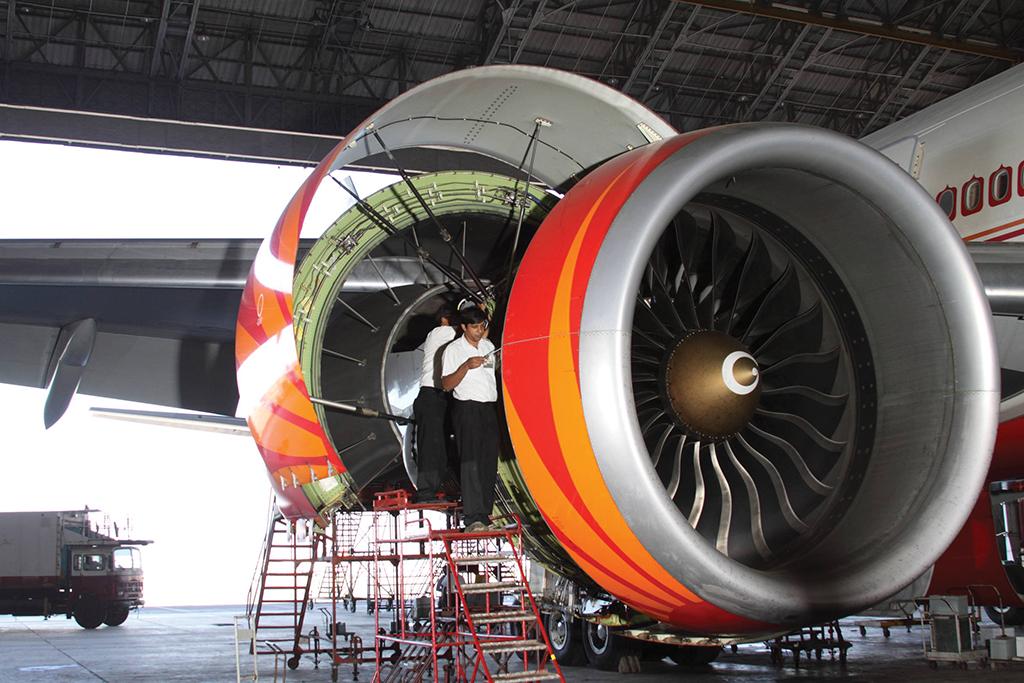
The growing fleets of Indian carriers have potential to boost the country’s aftermarket—if costs do not drive them to outsource maintenance.
India has become a focal point of the global aviation industry, with Air India possibly ordering about 300 aircraft, providing a much-needed post-pandemic boost to airframer OEMs. What is missing, however, is any immediate benefit to the country’s MRO industry.
“[At] the rate at which the Indian market is expanding, India will have more than 2,000 commercial aircraft in the next 10 years,” predicts Arun Kashyap, head of engineering at Air India. “Thus the need to develop capabilities for airframes, engines and components to support the maintenance of these aircraft within India is more [important] than ever.”
The Indian government is making a significant effort to launch India as an international aviation hub. With schemes such as regional connectivity and UDAN (a Hindi acronym that also means “flight”), through which Delhi will provide air connectivity to underserved airports, the Civil Aviation Ministry is planning to expand and modernize over 200 airports in the next two years. So why is the MRO sector being pushed back into the shadows?
Aircraft maintenance, at 11%, is an airlines’ second-highest cost after fuel. India has an abundance of skilled workers and strategic locations for establishing and developing MROs. Despite this, why are carriers outsourcing their maintenance and bearing the foreign exchange brunt?
The global aviation industry suffered during the COVID-19 pandemic, but the recovery time has been drastically worse for India compared to the West. Europe and the U.S. have the ecosystem required to pick up aviation business in-country, but Indian operators are entirely dependent on foreign MROs for maintenance support.
MRO capabilities in the country are limited for line and airframe maintenance. In airports managed by the Airports Authority of India (AAI), MROs must pay a royalty, over and above government taxes, to use airport land. The payments—often presented in an abstract, rudimentary form with no fixed terms or rules—are effectively another tax even if called a “royalty.” The sums can range from 18-52% of rent payments, with no restrictions on the amount, and act as a major deterrent for business. “The ecosystem of hangar rental charges is prohibitive for anyone to set up a widebody maintenance base,” says Sisira Dash, senior vice president of Vistara.
AAI has come up with a business-friendly proposal for setting up MROs with no airport royalty charges and significantly rationalized land rentals at eight Indian airports: Begumpet Airport in Hyderabad, Bhopal, Chandigarh, Chennai, Delhi, Juhu Airport in Mumbai, Kolkata and Tirupati. The question is whether these locations are commercially viable for Indian MROs.
Another issue requiring clarification is the goods and services tax (GST) rate that will be applied to the goods used for MRO repair services.
“The intent of the airline is to avail [itself of] the repair services from the MRO, [but the] services may have a higher value of parts embedded . . . compared to the value of services,” says Mrigank Pathak, senior director of HaveUs Aerotech India. “This, in turn, is causing a challenge for the MRO [as to] whether [the] MRO services provided to airlines will constitute a supply of goods (with a GST rate of 5%, 12%, 18% or 28% based on the supply of goods) or services (having a 5% fixed GST rate).”

The tax benefits are proving effective for airframe MROs, as they have lowered overall costs for MROs. Business is robust at Indian MROs for in-service aircraft from operators, which are all being mainained in-country, though with some capability or capacity limitations.
“MRO service for airframe maintenance is getting significant traction with GMR, Air Works India, [Air India Engineering Services Ltd. (AIESL)], and AAR taking [the] lead in this space to handle D checks for commercial aircraft widely used in India,” Kashyap says.
A major obstacle is European Union Aviation Safety Agency (EASA) or FAA approvals. As most airlines work on leased assets, they must evaluate the lease agreements carefully for heavy checks. EASA and the FAA are the internationally accepted regulatory bodies controlling the majority of global aviation regulations, so MROs naturally need to be certified by them to set up business. Lessors also mandate that all lease-returned aircraft must have EASA or FAA certification, so such certifications have become pertinent for domestic MROs in developing countries.
“The taxation in India is really problematic,” says Amrish Agarwal, associate vice president of engineering at IndiGo. “In cases of a lease-return aircraft, if the aircraft goes to an Indian MRO facility the airline has to pay an additional tax of 5-10% GST, just because the aircraft is serviced in India. This is one of the major reasons for Indian airlines to send their lease-return aircraft to countries like Singapore or Malaysia for servicing.”
The situation gets further complicated by imported components that need to be fitted on the lease-return aircraft, especially engines. “The Indian government imposes a tax on such components, which is over and above the fee that an airline pays to the MRO,” says Agarwal, who stresses that this tax regime needs to change.
Indian MROs are also struggling to develop component repair shops, as OEMs refrain from providing the much-needed technical knowledge, skills and tools to develop these shops in India. Though AIESL, India’s biggest MRO, has the capability to overhaul CFM56-5B and CFM56-7B engines, no Indian or foreign airline engines are sent its way for maintenance work. Due to a lack of technical documentation, AIESL’s operations remain outdated in terms of the latest innovations and engines. Because of this, the country’s MRO infrastructure is entirely dependent on foreign parties.
“Overseas MRO players not only have state-of-the-art infrastructure and advanced technology but are also financially sound,” Pathak says. “Indian MRO players fall short of their overseas competitors in technology, capability and finances. Also, most overseas MROs are subsidiaries of airlines, e.g., Air France, Lufthansa and Turkish Technic. They are easily able to get apt support from OEMs to develop MRO capability and capitalize on the business opportunities. This is the biggest disadvantage for Indian MROs.”
When an airline purchases an aircraft, it gets certain rights to a particular training module. But most airlines do not use these modules, and MROs have no access to them. To change this, airlines will need to be more proactive about delegating these updated modules to MROs.
“The delegation can happen, but the MROs need to come forward, stand firm and give us good business deals. Only then can we delegate the advanced training modules to the MROs,” Agarwal says. “Here, a bigger picture has to come into play where the OEMs, airlines and MROs get together on a common platform.” He adds that the government must help drive this progress.
Another issue is work on the bigger components such as engines and landing gear. Engine overhaul is very capital intensive, and Indian MROs do not have the capacity for engine heavy checks.
India’s government recently slashed the GST to 5% from 18% on domestic MRO services in an attempt to accelerate the pace of setting up MRO services. But has it worked?

“While a decrease in the rate of GST on MRO services has been a welcome measure by the airline operators, there is no corresponding change in the GST rates on the input leg (i.e., 5%, 12%, 18% or 28%), thus creating a working capital blockage on account of the inverted duty structure,” Pathak says. “Though the refund of GST paid on inputs will be available to the Indian MRO operator after a certain period, the cash-flow blockage results in an increased cost of operations for the MROs.”
Besides, taxes are levied during the import of goods from overseas, for which no claim mechanism is available. “Provision should be available to claim the refund at the time of export of [the] same goods overseas,” Pathak concludes.
According to Vistara’s Dash, another significant issue is rectifying dual-use parts to differentiate between their aeronautical and commercial usages. “This is one area that everyone is eagerly looking to be sorted out,” he urges.
But there are even bigger issues to be tackled. For instance, the taxes levied on airlines are preventing them from sending business to indigenous MROs. Indian operators prefer to take aircraft for maintenance to neighboring countries with comparatively negligible taxes.
“The MROs will get business only if the airlines are not taxed,” Agarwal asserts. “Thus, reducing the taxes on MROs brings very little to the table, as airlines continue to bear the brunt of heavy taxation. Naturally, it makes more sense for the airlines to take their aircraft outside the country for repair.”
M.P. Sajumon, senior manager of projects, contracts and new initiatives at AirAsia India, agrees. “To make the services at par and competitive with international MROs, a tax incentive needs to be given to the airlines to encourage Indian MRO services over foreign MRO services,” he says.
The entire MRO ecosystem must be developed to encourage Indian as well as foreign carriers to do business in the country. A holistic solution where OEMs, MROs and airlines work together is necessary, and India may want to study Singapore’s model.
Massive delegation rights for aircraft maintenance will follow on from Air India’s upcoming 200-aircraft deal. The MRO that will maintain them must look into getting these delegation rights, and developing the capability, to avoid a major lost opportunity.
Safran’s entry into India will slowly change the country’s aftermarket. “This is a significant development for the MRO sector in India,” says Air India’s Kashyap. “This is just the beginning of a new era of ‘Maintain in India,’” he adds, a reference to the government-led “Make in India” initiative.”
For OEMs to set up an MRO shop in India, two vital elements are robust business volume and a congenial business environment. India already has the necessary volume, given what is being outsourced. “The second element is to set up a sound infrastructure and [a] tax-free term to set up the [that] infrastructure,” Sajumon says.
Governments of states such as Karnataka and Uttar Pradesh have taken proactive steps to develop sound aerospace and defense policy to attract foreign OEMs and generate employment. Going forward, more states are expected to take a page out of the Hyderabad government’s policies and set up flexible norms for attracting OEMs to the country.
“Making a [special economic zone] is not the only solution,” Agarwal says. “We need to understand aviation as an entire industry. The entire MRO ecosystem has to be developed to get both Indian . . . [and] foreign carriers to India.”
Though various OEMs have set up MRO bases, they are more dependent on their captive business, rather than developing a complete market strategy. “What can drive the growth in the component MRO sector is an up-front commitment with OEMs during the selection stage,” Dash suggests. “Most of the components [that] are under warranty do not benefit any MRO in India, as most of them are exported out to existing warranty shops outside India. Unless we are able to demonstrate [lowering] the cost of repair in India and make it more cost-effective than sending out and bringing back the component, this sector will always lag with respect to competitors.”
Rohit Tomar, managing partner of Caladrius Aero Consulting, echoes that advice. “Safran’s investment in Hyderabad is not very positive, as the deal has more to do with defense MRO and, as a result, Safran has pushed the Leap MRO facility,” he says. Tomar points out that the government has not set a definite policy to attract foreign component manufacturers, so it needs to look at what makes MROs tick and follow the Singapore and Malaysia models.
“We have seen restrictive policies being applied in countries like Malaysia that enabled the OEM growth in their country, but the [Indian] government is taking one step ahead and two steps backward when it comes to putting up a definitive stand toward making the OEMs set up their shops in India,” he says.
Now is the time for Indian authorities and regulators to broaden their perspectives and build a sound MRO ecosystem that benefits both established and developing MROs. “The Indian aerospace MRO industry has been neglected for too long, and now the time is ripe to give the MROs the much-needed support, capability guidance and flexible policies that they deserve,” concludes Kashyap.




